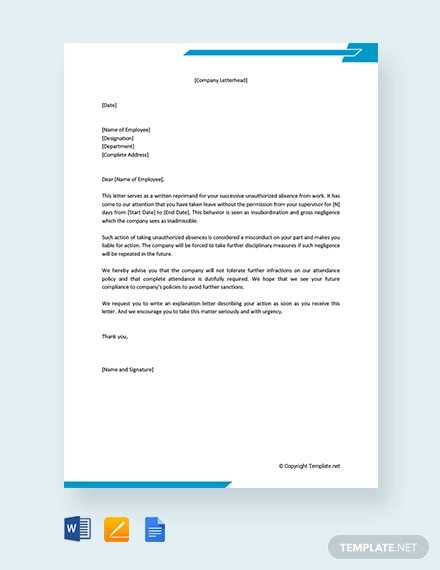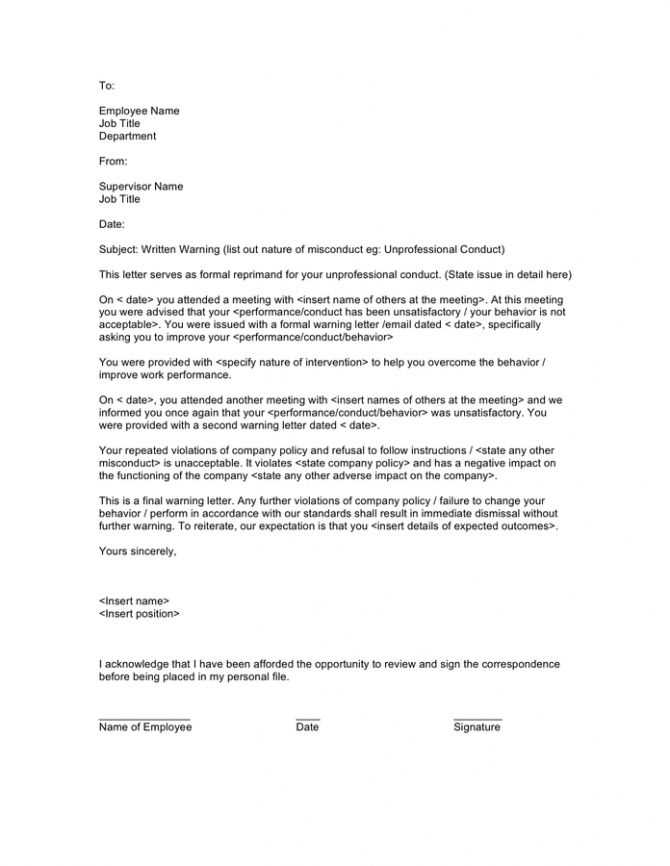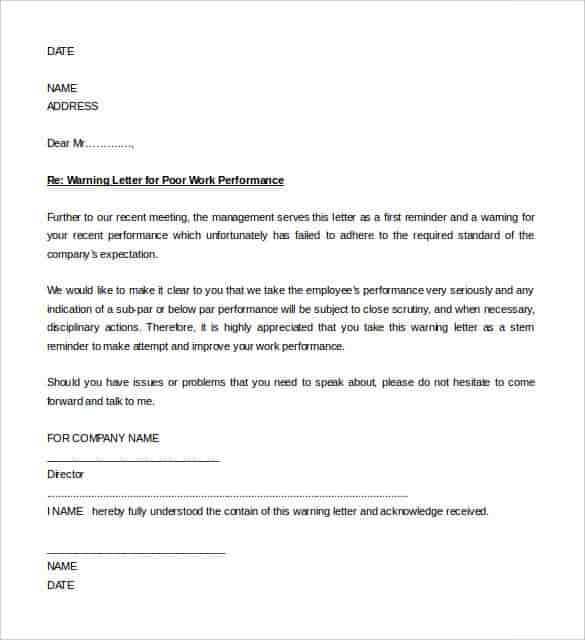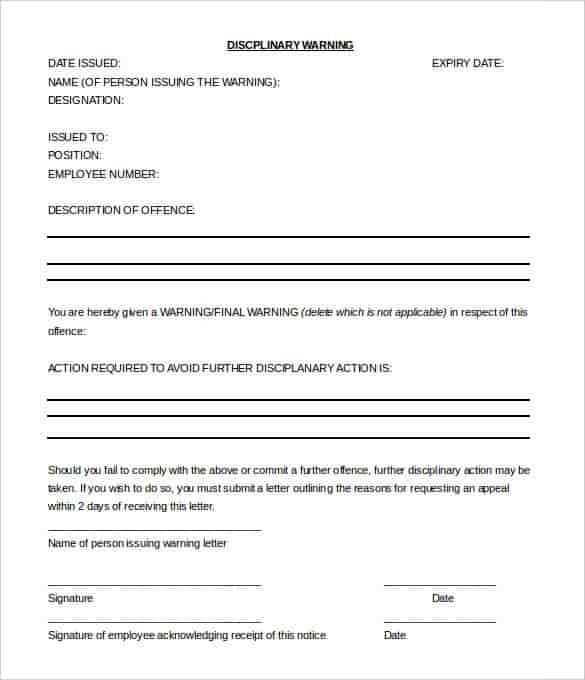Employee Reprimand Letter Template for Effective Communication

When issues arise in the workplace, addressing them promptly and professionally is essential for maintaining a healthy and productive environment. Clear communication is key to resolving conflicts and ensuring that both management and staff are on the same page. Having a structured approach for documenting concerns can help avoid misunderstandings and provide a formal record for future reference.
Clear documentation plays an important role in this process, offering a way to communicate serious concerns while providing a fair chance for employees to improve. This formal approach ensures transparency and promotes accountability, which can be beneficial for both the individual and the overall team dynamics.
By taking a thoughtful and constructive approach, managers can address issues in a manner that encourages improvement rather than creating unnecessary conflict. It’s crucial to remain professional and objective throughout the process, focusing on the desired outcome: better performance and a more harmonious work environment.
How to Write an Effective Reprimand
Addressing workplace misconduct or performance issues in a written form requires careful thought and precision. The message must be clear and direct, focusing on the behavior that needs improvement rather than personal criticism. It is important to keep the tone respectful, as the goal is to encourage growth and maintain a positive working relationship.
Be specific about the issue at hand. Avoid vague statements and provide concrete examples of the actions or behaviors that are problematic. This helps the recipient understand exactly what needs to change. Offering a clear context for why the behavior is an issue will also allow the individual to see the impact on the team or company.
Maintain professionalism throughout the communication. The tone should be neutral, and the message should focus on improvement rather than punishment. It’s crucial to emphasize that the intent is to help the individual develop and succeed in their role.
Additionally, providing guidance for improvement is an essential component. Suggest specific actions or steps the individual can take to address the issues. By offering support and a clear path forward, the message becomes more constructive and less confrontational.
Key Elements of a Reprimand Letter
For an official communication addressing workplace behavior or performance concerns, it’s essential to include several key components to ensure clarity and fairness. A well-structured document should outline the problem, provide context, and suggest next steps for improvement. These elements help maintain professionalism and allow the recipient to understand the issue fully.
Introduction and Purpose
The opening section should clearly explain the purpose of the communication. This is where the reason for the message should be directly stated. Be concise and avoid unnecessary elaboration.
- State the reason for the message.
- Identify the behavior or performance that needs addressing.
Details and Context

Providing specific examples and context is crucial for the recipient to understand the scope of the issue. Clear descriptions ensure there is no confusion about what actions or behaviors need to be addressed.
- Provide specific instances of problematic actions or behavior.
- Explain how these actions have affected the workplace.
Suggestions for Improvement
Offering a path forward is essential. By suggesting clear steps for correction, the individual will have a better understanding of what is expected moving forward.
- Outline clear and achievable steps for improvement.
- Offer assistance or resources if appropriate.
When to Issue a Reprimand Letter
Determining the right time to address workplace issues through formal communication is essential for maintaining a productive environment. It is important to act promptly, but only when the situation warrants it. Issuing a formal document should not be the first response, but rather a step taken after other attempts to resolve the matter have been ineffective.
After Verbal Warnings
Before escalating to a formal document, it is usually advisable to address the issue verbally. If repeated verbal discussions fail to lead to improvement, a written record may be necessary to ensure that the message is clearly communicated and documented for future reference.
- If verbal attempts have been unsuccessful, consider a formal approach.
- Ensure that the individual has had ample opportunity to correct the issue.
When the Issue Affects Team Performance
Formal communication may also be necessary when the behavior or performance issue begins to impact the broader team or organization. A situation that disrupts team dynamics or productivity requires timely intervention to maintain overall efficiency and morale.
- Use written communication when the problem escalates and affects others.
- Address issues promptly to prevent further negative consequences.
Legal Considerations for Employee Discipline
When addressing workplace issues, it is crucial to ensure that all actions are in compliance with legal requirements. Formal steps must be taken with care to avoid any violations of labor laws or contractual agreements. Understanding the legal framework surrounding discipline is essential to ensure that decisions are fair, consistent, and defensible if challenged.
Understanding Employment Laws
Different regions have various laws that govern how workplace behavior and performance should be handled. Familiarizing yourself with these regulations helps to avoid potential legal risks and ensures that all steps taken are within the boundaries of the law.
| Legal Area | Description |
|---|---|
| Anti-Discrimination Laws | Ensure that any actions are not based on race, gender, disability, or other protected characteristics. |
| Employment Contracts | Verify that any disciplinary action does not violate terms outlined in the agreement. |
| Workers’ Rights | Make sure the process respects employees’ legal rights and due process. |
Consistency in Application

To prevent claims of favoritism or bias, it is essential that all disciplinary measures are applied consistently across the organization. This ensures fairness and reduces the risk of legal disputes related to unequal treatment.
Common Mistakes to Avoid in Reprimands
When addressing behavioral or performance issues in writing, it is crucial to approach the situation carefully. Several common pitfalls can undermine the effectiveness of the communication or even create additional problems. Being aware of these mistakes can help ensure that the process remains professional, clear, and constructive.
Lack of Specificity
One of the most frequent errors is being too vague when describing the issue. General or ambiguous statements do not provide enough clarity for the recipient to understand what needs to be corrected. It is important to be specific and provide concrete examples of the behavior or actions in question.
- Avoid general phrases like “poor performance” or “inappropriate behavior.”
- Provide detailed examples to make the issue clear.
Emotional or Personal Tone

Another mistake is letting emotions influence the tone of the communication. A reprimand should remain professional and focused on the issue at hand, not on personal judgments or feelings. Writing with an angry or accusatory tone can lead to defensiveness and hinder the chance for a constructive conversation.
- Keep the tone neutral and objective.
- Avoid making personal attacks or expressing frustration.
Tips for Delivering Constructive Feedback

Providing feedback effectively is essential for encouraging improvement while maintaining a positive working relationship. When done right, it helps individuals understand what needs to be changed and how to approach it. Constructive feedback should focus on the issue, not the person, and should be delivered in a way that motivates positive action.
Focus on Behavior, Not Personality
Ensure that the feedback addresses specific actions or behaviors rather than making personal judgments. This approach keeps the conversation professional and ensures that the recipient feels the feedback is about their work, not who they are as a person.
- Be clear about the behaviors that need improvement.
- Keep the feedback relevant to the specific situation.
Offer Solutions and Guidance
Along with pointing out areas for improvement, it’s crucial to offer clear suggestions for how to address the issue. This helps the individual feel supported and empowers them to take the necessary steps toward improvement.
- Provide specific steps or strategies for improvement.
- Offer assistance or resources if necessary.